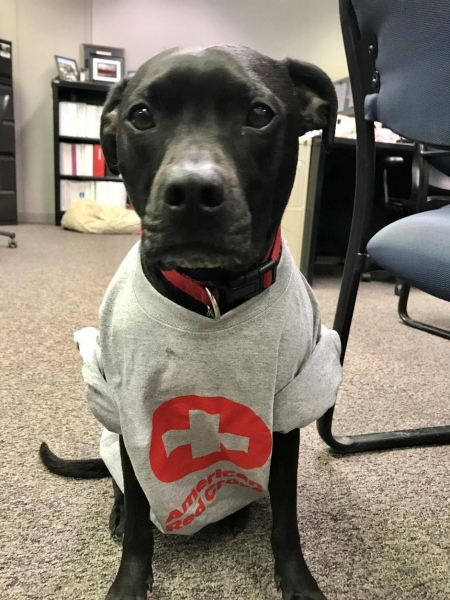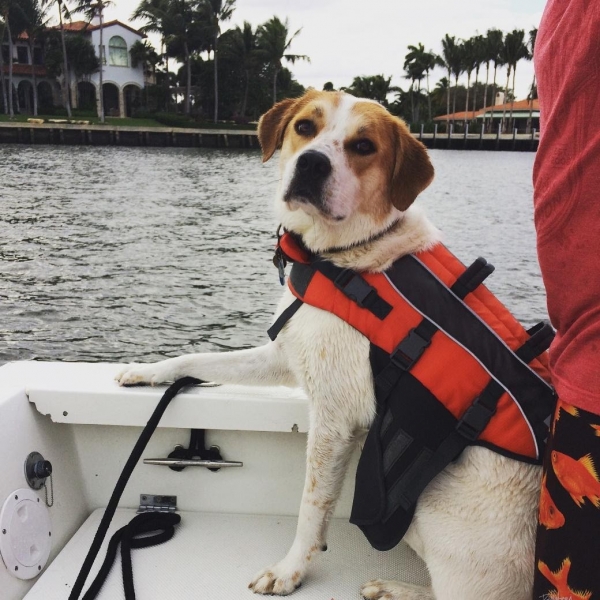
Just last week, NOAA announced the 2020 Atlantic Hurricane Season predictions. Many of us take this time to ensure we’re prepared for hurricanes and other disasters. Usually, the Office of Response and Restoration shares tips about protecting yourself, your property, and the marine environment before, during, and after a hurricane. But, while many of the OR&R staff are making personal preparedness efforts, they’re also preparing for their furry family members. We at the Disaster Preparedness Program believe it’s important to not only be prepared for ourselves, but for our pets, too!
Get Informed
The first step in being prepared is to be informed. This means do some research. Learn about the disasters that are most likely to occur in your area. Know which of those could end up leading to shelter-in-place orders and which mean it’s time to evacuate. When a disaster is approaching, always keep a NOAA weather radio nearby and monitor your local emergency authorities.
But getting informed doesn’t only mean knowing your surroundings—it means knowing what your pet needs during a disaster. This will help you make a plan.
Make a Plan

Studies show that those who make a plan and test it regularly have a higher rate of progressing through those steps during a disaster. This includes your pet’s plan, too! Here are some tips from the OR&R staff:
- Create a buddy system: have a couple of nearby, trusted friends or neighbors who can help if you’re not home when a disaster occurs.
- Make a list of veterinarians who have emergency services and hours.
- Get your pet microchipped—and keep the contact information up-to-date.
- Take a companion animal first aid class.
- Keep an extra month’s supply of your pet’s food and medication on-hand.
- Keep your pet’s vaccinations up-to-date—and keep a copy available at all times.
Laurie Sullivan, an environmental scientist with the OR&R Assessment and Restoration Division says, “Microchipping is really the number one thing for me. I discovered that my cat’s microchip was not registered to me, but to the shelter from where I adopted him.”
In addition, if your pets stay outside for extended periods of time each day, be sure to bring them in prior to the storm or disaster. Many times, our pets can become scared, injured, and sometimes even lost if they are left outside during a disaster.
If you have to evacuate, it’s important to:
- Pre-identify nearby shelters/kennels where your pet could stay.
- Pre-identify pet-friendly hotels along your evacuations routes (and know if they have any rules or restrictions).
- Have adequate kennels or carriers available for your pet while moving from place-to-place.
Making an emergency plan—and testing it with your pet—will ensure you’ve thought of the essentials needed when a disaster strikes.
Build a Kit

Just as FEMA and other agencies recommend for people, building an emergency kit for your pet is an easy way to keep all the essentials in one place and ready to go when disasters strike.
Sarah Latshaw, the Southeast regional coordinator with OR&R’s Marine Debris Program says, “I put together a ‘go-kit’ for each of my pets with the essential items they’ll need—this is a great way to make sure they have what they need to be safe and occupied during a disaster.”
The OR&R staff shared some items in their pet’s emergency kits:
- Food.
- Water—at least seven days’ worth for each pet.
- Bowls (collapsible to save space).
- Medication.
- Toys (to comfort and reduce stress/boredom).
- Bedding—sometimes just the smell of home is enough to reduce stress!
- Kennel/carrier.
- Leash/harness/collar/etc.
- Vet records (as current as possible).
- Current vaccine tag(s) such as rabies.
- A current picture of your pet.
- Sanitation needs (litter, litter box, pet waste bags, liquid dish soap, etc.).
- First aid kit with supplies (bandages, tape, scissors, antibiotic ointment, latex gloves, alcohol, saline).
- Flea/tick prevention.
- Flashlight.
Other Tips from the OR&R Staff

Some of our OR&R staff have older pets. One recommendation for older dogs was to keep a spare towel or blanket available to help your pet move. Wrapping a towel or blanket under their hips can be an easy way to help them walk.
Amy Merten, the West Coast Branch regional manager for OR&R’s Assessment and Restoration Division said, “My dog is falling a lot as she is getting old, so I’d suggest keeping cravats or other equipment around that can help you move your pet if they become injured.”
If you live in a hurricane- and/or flood-prone area, Jennifer Simms, communications and education specialist for OR&R’s Marine Debris Program, says, “If your dog isn’t a good swimmer, purchase protective gear (like a K-9 life vest) just in case.” These specific life vests help dogs that aren’t strong swimmers navigate through high waters and can be helpful in a disaster situation.
For those who have chickens, goats, and other non-companion pets, Sarah Latshaw recommends “locking them inside a sturdy and secure shelter with enough food and water to last several days.” This will reduce their risk of becoming injured during the storm.

And finally, the OR&R team recommends checking your property after a disaster and removing any hazards before you let your pets roam freely. This will reduce their chance of getting injured and help to return their environment back to its normal state.
June is not only the beginning of the Atlantic Hurricane season, it’s also Pet Preparedness Month. Those of us at the Disaster Preparedness Program urge you to take this time to get informed, make a plan, and build a kit for yourself and your pets!
